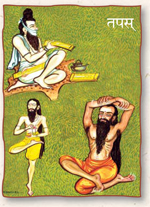
C H A P T E R 4 2§
Hinduism’s Code of Conduct
_______________
Twenty Keys for Spiritual Living in Contemporary Times
_______________
 OW OFTEN DO YOU SEE A PROFESSIONAL TEAM of people misbehave on the job? You’re on a flight from San Francisco to Singapore. Do the flight attendants bicker in the aisle? Of course not. People at this level of business have control of their minds and emotions. If they didn’t, they would soon be replaced. When they are on the job, at least, they follow a code of conduct spelled out in detail by the corporation. It’s not unlike the moral code of any religion, outlining sound ethics for respect and harmony among humans. Those seeking to be successful in life strive to fulfill a moral code whether “on the job” or off. Does Hinduism and its scriptures on yoga have such a code? Yes: twenty ethical guidelines called yamas and niyamas, “restraints and observances.” These “do’s” and “don’ts” are found in the 6,000 to 8,000-year-old Vedas, mankind’s oldest body of scripture, and in other holy texts expounding the path of yoga. §
OW OFTEN DO YOU SEE A PROFESSIONAL TEAM of people misbehave on the job? You’re on a flight from San Francisco to Singapore. Do the flight attendants bicker in the aisle? Of course not. People at this level of business have control of their minds and emotions. If they didn’t, they would soon be replaced. When they are on the job, at least, they follow a code of conduct spelled out in detail by the corporation. It’s not unlike the moral code of any religion, outlining sound ethics for respect and harmony among humans. Those seeking to be successful in life strive to fulfill a moral code whether “on the job” or off. Does Hinduism and its scriptures on yoga have such a code? Yes: twenty ethical guidelines called yamas and niyamas, “restraints and observances.” These “do’s” and “don’ts” are found in the 6,000 to 8,000-year-old Vedas, mankind’s oldest body of scripture, and in other holy texts expounding the path of yoga. §
The yamas and niyamas are a common-sense code recorded in the final section of the Vedas, called Upanishads, namely the Shandilya and the Varuha. They are also found in the Hatha Yoga Pradipika by Gorakshanatha, the Tirumantiram of Tirumular and in the Yoga Sutras of Patanjali. The yamas and niyamas have been preserved through the centuries as the foundation, the first and second stage, of the eight-staged practice of yoga. Yet, they are fundamental to all beings, expected aims of everyone in society, and assumed to be fully intact for anyone seeking life’s highest aim in the pursuit called yoga. §
Sage Patanjali (ca 200 BCE), raja yoga’s foremost propounder, told us, “These yamas are not limited by class, country, time (past, present or future) or situation. Hence they are called the universal great vows.” Yogic scholar Swami Brahmananda Saraswati revealed the inner science of yama and niyama. They are the means, he said, to control the vitarkas, the cruel mental waves or thoughts, that when acted upon result in injury to others, untruthfulness, hoarding, discontent, indolence or selfishness. He stated, “For each vitarka you have, you can create its opposite through yama and niyama, and make your life successful.” §
The following paragraphs, with accompanying illustrations by A. Manivel of Chennai, elucidate the yamas and niyamas. Presented first are the ten yamas, the do not’s, which harness the instinctive nature, with its governing impulses of fear, anger, jealousy, selfishness, greed and lust. Second are illustrated the ten niyamas, the do’s, the religious observances that cultivate and bring forth the refined soul qualities, lifting awareness into the consciousness of the higher chakras of love, compassion, selflessness, intelligence and bliss. Together the yamas and niyamas provide the foundation to support our yoga practice so that attainments in higher consciousness can be sustained.§
The Ten Vedic Restraints, Yama æº
1. Noninjury, Ahimsa §
Practice noninjury, not harming others by thought, word or deed, even in your dreams. Live a kindly life, revering all beings as expressions of the One Divine energy. Let go of fear and insecurity, the sources of abuse. Knowing that harm caused to others unfailingly returns to oneself, live peacefully with God’s creation. Never be a source of dread, pain or injury. Follow a vegetarian diet.§
2. Truthfulness, Satya §
Adhere to truthfulness, refraining from lying and betraying promises. Speak only that which is true, kind, helpful and necessary. Knowing that deception creates distance, don’t keep secrets from family or loved ones. Be fair, accurate and frank in discussions, a stranger to deceit. Admit your failings. Do not engage in slander, gossip or backbiting. Do not bear false witness against another. §
3. Nonstealing, Asteya §
Uphold the virtue of nonstealing, neither thieving, coveting nor failing to repay debt. Control your desires and live within your means. Do not use borrowed resources for unintended purposes or keep them past due. Do not gamble or defraud others. Do not renege on promises. Do not use others’ names, words, resources or rights without permission and acknowledgement. §
4. Divine Conduct, Brahmacharya §
Practice divine conduct, controlling lust by remaining celibate when single and faithful in marriage. Before marriage, use vital energies in study, and after marriage in creating family success. Don’t waste the sacred force by promiscuity in thought, word or deed. Be restrained with the opposite sex. Seek holy company. Dress and speak modestly. Shun pornography, sexual humor and violence. §
5. Patience, Kshama §
Exercise patience, restraining intolerance with people and impatience with circumstances. Be agreeable. Let others behave according to their nature, without adjusting to you. Don’t argue, dominate conversations or interrupt others. Don’t be in a hurry. Be patient with children and the elderly. Minimize stress by keeping worries at bay. Remain poised in good times and bad. §
6. Steadfastness, Dhriti §
Foster steadfastness, overcoming nonperseverance, fear, indecision and changeableness. Achieve your goals with a prayer, purpose, plan, persistence and push. Be firm in your decisions. Avoid sloth and procrastination. Develop willpower, courage and industriousness. Overcome obstacles. Never carp or complain. Do not let opposition or fear of failure result in changing strategies. §
7. Compassion, Daya §
Practice compassion, conquering callous, cruel and insensitive feelings toward all beings. See God everywhere. Be kind to people, animals, plants and the Earth itself. Forgive those who apologize and show true remorse. Foster sympathy for others’ needs and suffering. Honor and assist those who are weak, impoverished, aged or in pain. Oppose family abuse and other cruelties. §
8. Honesty, Arjava §
Maintain honesty, renouncing deception and wrongdoing. Act honorably even in hard times. Obey the laws of your nation and locale. Pay your taxes. Be straightforward in business. Do an honest day’s work. Do not bribe or accept bribes. Do not cheat, deceive or circumvent to achieve an end. Be frank with yourself. Face and accept your faults without blaming them on others. §
9. Moderate Appetite, Mitahara §
Be moderate in appetite, neither eating too much nor consuming meat, fish, shellfish, fowl or eggs. Enjoy fresh, wholesome vegetarian foods that vitalize the body. Avoid junk food. Drink in moderation. Eat at regular times, only when hungry, at a moderate pace, never between meals, in a disturbed atmosphere or when upset. Follow a simple diet, avoiding rich or fancy fare. §
10. Purity, Saucha §
Uphold the ethic of purity, avoiding impurity in mind, body and speech. Maintain a clean, healthy body. Keep a pure, uncluttered home and workplace. Act virtuously. Keep good company, never mixing with adulterers, thieves or other impure people. Keep away from pornography and violence. Never use harsh, angered or indecent language. Worship devoutly. Meditate daily. §
The Ten Vedic Practices, Niyama æº
1. Remorse, Hri §
Allow yourself the expression of remorse, being modest and showing shame for misdeeds. Recognize your errors, confess and make amends. Sincerely apologize to those hurt by your words or deeds. Resolve all contention before sleep. Seek out and correct your faults and bad habits. Welcome correction as a means to bettering yourself. Do not boast. Shun pride and pretension.§
2. Contentment, Santosha §
Nurture contentment, seeking joy and serenity in life. Be happy, smile and uplift others. Live in constant gratitude for your health, your friends and your belongings, Don’t complain about what you don’t possess. Identify with the eternal You, rather than mind, body or emotions. Keep the mountaintop view that life is an opportunity for spiritual progress. Live in the eternal now. §
3. Giving, Dana §
Be generous to a fault, giving liberally without thought of reward. Tithe, offering one-tenth of your gross income (dashamamsha), as God’s money, to temples, ashrams and spiritual organizations. Approach the temple with offerings. Visit gurus with gifts in hand. Donate religious literature. Feed and give to those in need. Bestow your time and talents without seeking praise. Treat guests as God.§
4. Faith, Astikya §
Cultivate an unshakable faith. Believe firmly in God, Gods, guru and your path to enlightenment. Trust in the words of the masters, the scriptures and traditions. Practice devotion and sadhana to inspire experiences that build advanced faith. Be loyal to your lineage, one with your satguru. Shun those who try to break your faith by argument and accusation. Avoid doubt and despair.§
5. Worship, Ishvara-Pujana §
Cultivate devotion through daily worship and meditation. Set aside one room of your home as God’s shrine. Offer fruit, flowers or food daily. Learn a simple puja and the chants. Meditate after each puja. Visit your shrine before and after leaving the house. Worship in heartfelt devotion, clearing the inner channels to God, Gods and guru so their grace flows toward you and loved ones.§
6. Scriptural Listening, Siddhanta Shravana §
Eagerly hear the scriptures, study the teachings and listen to the wise of your lineage. Choose a guru, follow his path and don’t waste time exploring other ways. Read, study and, above all, listen to readings and dissertations by which wisdom flows from knower to seeker. Avoid secondary texts that preach violence. Revere and study the revealed scriptures, the Vedas and Agamas. §
7. Cognition, Mati §
Develop a spiritual will and intellect with your satguru’s guidance. Strive for knowledge of God, to awaken the light within. Discover the hidden lesson in each experience to develop a profound understanding of life and yourself. Through meditation, cultivate intuition by listening to the still, small voice within, by understanding the subtle sciences, inner worlds and mystical texts.§
8. Sacred Vows, Vrata§
Embrace religious vows, rules and observances and never waver in fulfilling them. Honor vows as spiritual contracts with your soul, your community, with God, Gods and guru. Take vows to harness the instinctive nature. Fast periodically. Pilgrimage yearly. Uphold your vows strictly, be they marriage, monasticism, nonaddiction, tithing, loyalty to a lineage, vegetarianism or nonsmoking.§
9. Recitation, Japa §
Chant your holy mantra daily, reciting the sacred sound, word or phrase given by your guru. Bathe first, quiet the mind and concentrate fully to let japa harmonize, purify and uplift you. Heed your instructions and chant the prescribed repetitions without fail. Live free of anger so that japa strengthens your higher nature. Let japa quell emotions and quiet the rivers of thought.§
10. Austerity, Tapas §
Practice austerity, serious disciplines, penance and sacrifice. Be ardent in worship, meditation and pilgrimage. Atone for misdeeds through penance (prayashchitta), such as 108 prostrations or fasting. Perform self-denial, giving up cherished possessions, money or time. Fulfill severe austerities at special times, under a satguru’s guidance, to ignite the inner fires of self-transformation. §


















